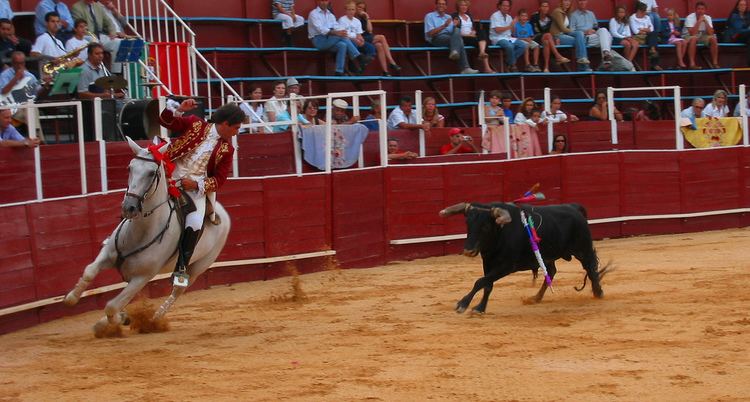 | ||
Portuguese-style bullfighting differs in many aspects from Spanish-style bullfighting. The cavaleiros and the forcados are unique as well as the horsewomen (cavaleiras).
Contents
Main figures
Stages
Most Portuguese bullfights (corridas de touros) are held in two phases: the spectacle of the cavaleiro, followed by the pega. In Portugal, the main stars of bullfighting are the cavaleiros, as opposed to Spain, where the matadores are the most prominent bullfighters. Nevertheless, bullfights with matadores are frequent, notably with Portuguese matadores who practice their trade in Spain and who, when in Portugal, replace the sword in their final strike with a bandarilha. Examples of famous Portuguese matadores are Vítor Mendes and Pedrito de Portugal.
During the cavaleiro, a horseman on a Portuguese Lusitano horse (specially trained for the fights) fights the bull from horseback. The purpose of this fight is to stab three or four bandeirilhas (small javelins) in the back of the bull.
In the second stage, called the pega, the forcados, a group of eight men, challenge the bull directly without any protection or weapon of defense. The front man provokes the bull into a charge to perform a pega de cara or pega de caras (face catch). The front man secures the animal's head and is quickly aided by his fellows who surround and secure the animal until he is subdued. Many people who watch Portuguese-style bullfights in the United States use the term, "suicide squad", to refer to this group of eight men.
The bull is not killed, at the end of the corrida, leading oxen are let into the arena and two campinos on foot herd the bull along them back to its pen. After the fight the bull may be either killed by a professional butcher or, after a good performance, restored to health and released to pasture for breeding. Nevertheless, tradition was so strong at the small frontier town of Barrancos, where the bull was illegally killed, that the government was forced to relent and permit the town to follow its ancient matador tradition and kill the bull.
There are other forms of traditional bullfighting in Portugal, some differing markedly from the version described above. In the Azores, bullfighting is often reminiscent of the running of the bulls in Pamplona (Spain) in the respect that those most at risk are human beings, not the bulls themselves. The Azorean style involves a group of people vying in a tug-of-war with a young bull by holding fast to a long stout rope tied around the bull's neck. This is called the tourada à corda (bull-on-a-rope 'game').
Hazards
In Portugal, some bulls have their horns severed and covered in a way that they do not present sharp points. This practice is believed to have been introduced by King Joseph I of Portugal after a tragic event in a bullfight over which he was presiding at Salvaterra de Magos. The son and heir of the 4th Marquis of Marialva was fighting a bull on horseback when the animal wounded his horse. The young man fell, was kicked by the bull and killed. The Marquis himself, then around 70 years of age, jumped from the royal cabin that he shared with the king, drew his sword and killed the animal.
Geographic distribution
Some southern and central regions of Portugal, such as Ribatejo Provincibatejo and parts of the Alentejo, as well as Terceira Island in the Azores, are traditionally more interested in the corrida de touros. In Portugal's northern regions, bullfighting has a much lower presence, excepting for Póvoa de Varzim where bullfighting arenas are known to exist, at various locations, since the 18th century. In Northern Portugal, Viana do Castelo prohibited bullfighting in 2009, However, the arena was only used once a year since the 1990s and its bullfighting locations can be traced to 1871. It is entirely absent from most Azorean islands and from Madeira.
The public television station RTP usually shows bullfights in prime-time. This has been notoriously criticized by left-wing parties who have tried to ban the programme and, in another instance, rating the show to an adults-only classification.
